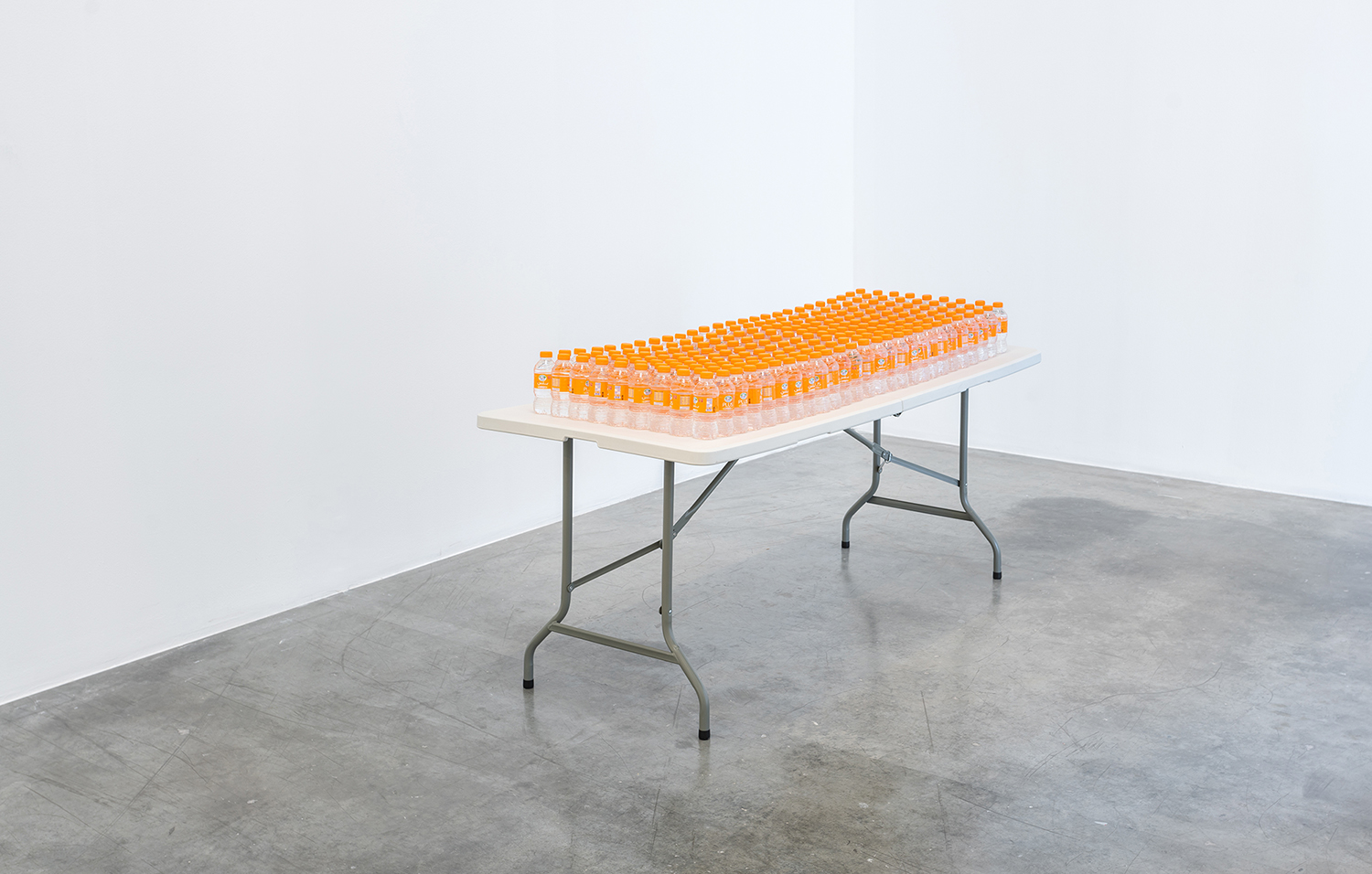Shows
Lantian Xie's “Full Special”


“Full Special” is a vernacular term used by drivers at gas stations across the United Arab Emirates. It indicates to station attendants to fill up the tank with the cheapest fuel option available. The frequently uttered phrase was the departure point for Nanjing-born, Dubai-based artist Lantian Xie’s second solo show at Dubai’s Grey Noise gallery. In “Full Special,” Xie examined the ritualized practices that make up the culture of the UAE, as well as the art world.

“Full” and “special” both suggest maxima. Fittingly, the first work visitors were greeted with was the installation Sunshine (all works 2018)—a table with neatly arranged plastic bottles of Al Ain Plus vitamin D water. Xie chose to utilize the orange-capped bottles because of the brand’s hyperbolic descriptor, “plus”—which he singles out as a symptom of the hyper-capitalist culture of Dubai in general, where everything is the biggest, the first, or the most—and the value supposedly added to the product by its vitamin D content, a paradoxical addition to a product marketed towards inhabitants of a desert metropolis. The installation is also a tongue-in-cheek nod to hospitality tables commonly found at public events around the UAE. When the show opened to guests on a warm September evening, several water bottles were immediately consumed. The confusion was exactly what Xie had hoped for: “I am always thinking about how to not make things that look like art,” he said. “I like the idea when something hovers between a sculpture and the thing itself.”
There were other ways that “Full Special” challenged viewers’ perceptions of what constitutes “proper” practice within the realm of contemporary art. One of the strategies that Xie employed was to hang the canvases in the show sparsely but subtly off-kilter. Day to Day, a painting depicting arms holding a warm orange canvas against a metal beam, with framed works on the floor in the background, was the artist’s hint for viewers to take a closer look at the positioning of the exhibits in the actual gallery space. Largest Quad Homes in Dubai, on the other hand, is a small-scale painted replica of a billboard advertisement for real estate in Dubai, originally displayed at the Indira Gandhi International Airport in New Delhi. Through the renderings of yet-to-be realized homes, Xie comments on how Dubai presents an idealized version of itself to attract potential overseas investors. Similarly drawing from mass-circulated images, Think Fast, Look Alive, a copy of the poster for the 1995 movie Die Hard, is an exuberant display of masculinity that embodies yet another maximal maxim—dying, hard. Adding a secondary layer to the meaning of the canvases was the fact that they were all produced by art forgers and muralists, thus bringing into question issues of authenticity and provenance. Xie did not pretend to teleport viewers into a transcendent experience through his art. Instead, he prompted visitors to reconsider what they were seeing in both the gallery and the city beyond.
Perhaps the artist’s fascination with deciphering one’s visual environs stems from his own position as both an “insider” and “outsider” in relation to Dubai. His experience growing up in Bahrain and then Dubai as a minority came to the surface with the work Welcome, a painting based on a cell-phone screenshot of celebrity-child North West. In the top left corner of the facsimile of the screen, where the name of the network carrier is normally displayed, was the message “Welcome. . .” In July 2018, on the occasion of Chinese president Xi Jinping’s three-day diplomatic visit to the UAE, mobile networks in Dubai changed their names to WelcomePresChina. Xie understood the message to be directed toward the Chinese immigrant community, and immortalized the moment.
As visitors walked through the show, they were made to listen to the music playing continuously via speakers. The 150 tracks—spanning American rap, Khaleeji pop music, as well as hits by Michael Jackson and Bob Marley—comprise Xie’s CD, which the artist found in a second-hand car that he purchased from an Emirati. Referencing exchanges surrounding oil and automobiles in Dubai, while creating an atmosphere like that of a commercial shop, CD, as with the other works in the gallery, shakes up the conventions upon which culture is built.
Lantian Xie's “Full Special” is on view at Grey Noise, Dubai, until November 1, 2018.







